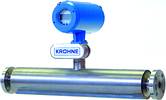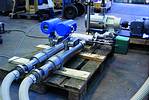

When the first Coriolis flowmeters appeared on the market decades ago, they were widely welcomed in industries where their direct measurement of mass flow was seen as an immediate benefit. Mass measurement before then had to be inferred from a knowledge of volumetric flow rate and fluid density, so the ability to measure mass flow rate direct from a single instrument was seen as a significant technological and economic advantage.
Unfortunately, many early designs of Coriolis meters did not live up to that early promise. The conventional designs at the time - bent or looped tubes, or split-flow tubes - proved unreliable on many applications where their direct-mass-reading capability should have been of most benefit. In the food processing industry, for example, the convoluted flow patterns and installation restrictions required of such meters meant they could not cope with the viscous, non-Newtonian, shear-sensitive or solids-bearing fluids typical of the industry.
All this changed in 1994 when Krohne introduced the world's first single straight tube Coriolis mass flowmeter. Compared with those earlier designs, the main advantage of this meter was its low pressure drop and a mechanical design that lent itself to hygienic construction, operation and choice of materials. The straight, single tube design has since proved to be a cost-effective solution for mass flow measurements across a wide range of industries, and has been taken up by several other instrument manufacturers.
Krohne, building on its decade of experience of a single tube Coriolis meter development, production and application, has launched a new family of single tube Coriolis mass flowmeters, Optimass, which could open up many more application areas for this technology. The main advantages of the new straight tube design are its ability to adjust to changing fluid densities through 'adaptive sensor technology', improved signal processing, and an ease of installation far better than conventional Coriolis meters.

Fundamental principles
The basic principle behind the new meter is similar to that of all straight tube Coriolis meters. Fundamentally, the instrument consists of a straight measuring tube, vibrated at its natural frequency by a driver positioned at the longitudinal mid-point of the tube. Two sensors positioned equidistant either side of the driver pick up the resulting tube displacement.
With no flow, both sensors record the same sine wave signal set up by the tube's vibration. With flow through the tube, however, Coriolis forces come into effect. A natural phenomenon, these are generated whenever a mass in a rotating system moves - the 'rotation' here being the tube's vibration. The Coriolis forces set up by the flowing mass of the fluid cause the measuring tube to deform, in turn causing a phase shift in the signals generated by the two sensors. This shift is extremely small - the change in tube displacement is not even visible to the naked eye - and may be only a matter of 5-10 microseconds difference. The difference in the phase angle of the two sensor signals generated by the Coriolis forces is directly proportional to the mass flow rate through the tube.
With such a sensitive measurement, it is clearly vital that the sensors can accurately record the tube displacement caused by the Coriolis effect. Early designs, however, suffered from 'noise' leakage from the ends of the tube - vibrations escaping from the meter into the up- and downstream piping. This noise in turn could be reflected back to the sensors, leading to errors in their output - and hence inaccuracies in the instrument. Such noise is generated particularly when the meter goes 'out of balance' due to a change in process fluid density (as can occur with fluctuating temperatures), which obviously changes the mass of fluid inside the measuring tube.
Krohne subsequently addressed this problem by using a spring-loaded mass absorber fitted around the outer casing of the tube, effectively acting as a counter weight to the driven tube plus flowing fluid and minimising the noise generated. Although this compensating mass is different for each size of meter, the variations that would be needed to allow for different product densities (ie, the mass of fluid in the tube) are just too much and would restrict each meter to one specific usage.
Even with these compensating masses, however, meters still had to be installed in accordance with recommended minimum clamping distances (typically a pipe length of 10 x tube diameter away from the meter).
New design
The goal for the new Optimass meter - developed over a four-year period - was to have an instrument totally independent of such installation limitations and fluid density variations. The design problem was to allow for end pipes strong enough to withstand the thermal and loading stress and G-force, yet weak enough to de-couple the instrument from outside interference.
The counter-balancing absorber mass and spring has now been replaced with an integral mass and spring system that uses the dynamic elements of the measuring system. The end connection tubes now act as the spring for the absorber mass system. The main benefit is that this 'spring' is self-compensating. As the density of fluid flowing through the meter changes, so the dynamic stiffness of the tube-ends (the 'spring in conjunction with the inner cylinder mass') also changes. The result is an inherently balanced system under all operating conditions. As no vibration escapes from the meter, the zero remains stable.
How this was done
At the heart of the Optimass design is 'adaptive sensor technology' (AST). Crucial to AST was the patented development of two dimensionless number groups. These mathematically link together the required length of the connecting tube, its Young's modulus, its bending moment of inertia, the mass of the inner cylinder and the measuring tube's natural frequency when full with water.
The design optimisation process involved using finite element analysis to solve for these groups, arriving at a design guide based on minimum values for the non-dimensional groups. Iteration to produce values above these minimums therefore results in a meter design that is adaptively tuned and independent of external forces and fluid density.
According to Krohne, competing instruments are not designed in this way. For example, instead of optimising around bending stiffness, one of them relies instead on torsion compensation. Krohne believes the AST technique gives Optimass a significant advantage over these other methods.
Further improvements
Apart from AST, the new Optimass meters feature two other important developments - one centred on the instrument's electronics, the other a new design of sanitary coupling for hygienic processing in industries such as food and pharmaceuticals.
Electronics
Krohne's current range of Coriolis meters offers a choice of instrument-mounted electronics/transmitter or remote mounting. The latter, however, is restricted to a maximum cable length of 5 m. In the Optimass design, part of the electronics is always mounted on the meter, with direct connection to the instrument's sensors. The sensor signals - temperature, strain, drive and phase shift measurements - are processed in this part after being converted from analog to digital. The signals are then transmitted digitally via RS485 to the main electronics converter - which can be mounted either on the instrument, or remotely up to 300 m away.
The front-end, close-coupled circuitry includes the A/D converter, processor, software and sensor coefficients and settings. All these front-end electronics are intrinsically safe, while the remote circuitry can be supplied as IS or 'increased safety'. All the sensor coefficients and settings are stored in both the front end and the back end converter. The latter, also housing the power supply, processing and output boards, is designed as a universal component, common to all models in the range. Customer parameters are stored here on removable EEPROM, so there is no need for reprogramming if the converter is exchanged or replaced.
Separating the electronic components in this way means that cabling (linking the two) need only be 4-wire, as opposed to competing systems requiring up to 10-wire cabling. The standard, off-the-shelf, 4-core screened cable provides one pair for the driver circuit and one pair for the bi-directional RS485 communications. Output from the converter is up to three 4-20 mA and one pulse/frequency signals.
The new electronics have also considerably improved the turndown capabilities of the meters, meaning that lower flows can now be accurately measured without having to undersize the meter for the application - which has been a problem with Coriolis meters in some food and pharmaceutical applications. Viscous fluid requires a large flow tube to reduce the pressure drop. But if the meter is capable of measuring low flow, then over-sizing is avoided.
Hygienic benefits
Also of interest to the food and pharmaceutical industries will be the new, patented hygienic coupling design available for the Optimass range. As with most single straight tube Coriolis meters, the standard Optimass uses a seamless titanium alloy (ASTM Grade 9) for the measuring tube. Connecting this to the stainless steel fittings required in hygienic operations has long been a problem for meter manufacturers. Conventional attempts at adding hygienic couplings to meters have proved cumbersome, because they effectively introduced an additional set of seals for each installation.
The Optimass design overcomes this titanium/stainless steel welding problem by means of a special adapter that simply screws on to the meter's welded end connections to accommodate DN 11864-2 connectors, without the need for any extra 'O' rings. A similar all-welded design for Tri-clamp hygienic fittings is under development and will be available soon.
Widening application areas
Although the standard meters have titanium tubes, other more conventional materials such as stainless steel and Hastelloy C22 are also available for most sizes in the Optimass range. Krohne believes these options should greatly increase the penetration of the meter in aggressive and corrosive chemical applications.
Another factor that will appeal to operators in the chemical industry is the much simpler installation stemming from the elimination of minimum clamping distance requirements. The long pipe runs associated with earlier designs are not needed, leading to what Krohne says is a 'dramatic' reduction in the cost of ownership of the meters.
Availability and performance
Although each meter is essentially 'made to order' at Krohne's UK operation in Wellingborough, Northamptonshire, the company is aiming to have them available on a two to four week delivery schedule.
Sizes in the range cover mass flow rates from 950 kg/h to 430 000 kg/h. All models are available in titanium grade 9, Hastelloy C22 or stainless steel, with DIN, ANSI or JIS flanges. Maximum operating temperature and pressure for the titanium models is 150°C and 6,3 MPa (63 bar) respectively, while for the Hastelloy and stainless steel models it is 100°C and 4 MPa (40 bar). All models feature secondary containment and optional heating jackets and purge ports.
Another part of the Optimass, designed to complement the straight tube instruments, features a single Z-tube configuration. Sharing the same common converter module as the straight tube range, this new low flow design is available in flow sizes from 15 to 350 kg/h.
All the Optimass meters will be thoroughly tested against all specifications before delivery. The comprehensive list includes zero stability, linearity, accuracy, repeatability, ambient and process temperature effects, pressure effects and installation effects. All test results are documented and available for review.
Optimass meters have been successfully trialed at a number of chemical and food industry sites. With their ability to provide mass flow rate and total mass, temperature, concentration, density and other parameters directly form the one instrument; they offer all the advantages of conventional Coriolis meters, but now with significant additional benefits of their own.
The development of AST has resulted in innovative instrument design that is independent of variations in fluid density and the installation limitations of conventional single straight tube Coriolis flowmeters.
For more information contact Gordon Duff, Krohne, 011 315 2685, [email protected], www.krohne.com
| Tel: | +27 11 314 1391 |
| Email: | [email protected] |
| www: | www.za.krohne.com |
| Articles: | More information and articles about KROHNE |

© Technews Publishing (Pty) Ltd | All Rights Reserved